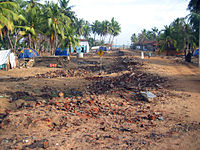| Revision as of 07:49, 11 June 2015 edit123.231.125.101 (talk)No edit summary← Previous edit | Revision as of 20:28, 18 June 2015 edit undo175.157.236.33 (talk) →External linksNext edit → | ||
| Line 47: | Line 47: | ||
| ==External links== | ==External links== | ||
| * | |||
| * | * | ||
Revision as of 20:28, 18 June 2015
This article has multiple issues. Please help improve it or discuss these issues on the talk page. (Learn how and when to remove these messages)
|
| Arugam | |
|---|---|
| Town | |
 Beach of Arugam Bay Beach of Arugam Bay |


Arugam Bay is a bay situated on the Indian Ocean in the dry zone of Sri Lanka's southeast coast. The bay is located 320 km due east of Colombo. "Ullai" as Arugam Bay is locally known is a popular surfing and tourist destination.Beyond surfing there are many things can be enjoyable, Lagoon tour, bird watching, elephant watching, Kumana National Park, Kudumpigala monarchy and many ancient ruins & archaeological sites. After the war ended, there are lot of tourist not only surfers but many nature lovers visiting Arugam Bay.
Development
Many of the buildings were destroyed in the 2004 tsunami. The Government's Min. of Defense CCD (Coastal Conservation Dept.) created what is now described as Arugam's second "Tsunami" end September 2011, when all beach side structures where demolished by bulldozers. Due to its popularity among tourists, the area has managed a slow recovery by private initiatives only. As late as 2011 no help has been received from any official source or international organizations. An exception is uncoordinated support for fishing folk as well as many school rebuilding programs, resulting in a continuation to provide only separatist schools for each community. Although there is a huge demand for an international school, one huge new building donated by the people of Japan remains largely unoccupied since the grand 'opening' ceremony in 2007.
The bay hosts a large fleet of fishing boats which operates off the beach. Many organizations donated boats after the tsunami and as a result there are far more fishing boats than ever before. The main beach is a bit dirty, compared to nearby beaches which are rather more aesthetically pleasing and also have excellent waves.
Development in Limbo
Many organizations claim to have done extensive work in the area. No notable progress can be observed locally and on close inspection, as late as New Year's Day, 2010. The main road, shown below in 2004 still looked the very same at the end of 2009. Despite calls for a walking street contractors have recently (September, 2010)completed construction of a fast trunk road through the hamlet. Repeating the mistakes made in other seaside tourist resorts such as Negombo and Hikkaduwa. US 'Mercy Corps' has been the most active of any organization. Funded by Oprah Winfrey's 'Angel Network', following a huge fund-raising TV series in the United States. Sadly, none of their projects survived the first year of operation. A new bridge has been constructed by USAID. It was opened for traffic in 2008. It replaced the 1960s, original landmark box girder construction linking Arugam Bay with Pottuvil. At km 312 on the main A4 (the famous Colombo High Level Rd. - PottuVille), an excellent shortcut side road exists, which ends up in the very middle of Arugam Bay itself. This picturesque drive avoids the dusty town of PottuVille. Also no bridges need to be crossed.
The more long lasting development efforts have been carried out by a consortium of two Italian NGOs, 'ICEI' and 'Overseas', which are the only development agencies still present in 2013 in the area, working on responsible tourism and sustainable agriculture. As a legacy for the work carried out by these two NGO, a local organization, acting as a social business, has been established: Ecowave. Ecowave is currently managing an outlet in the main street of Arugam Bay, providing market opportunities to the farmers, and offering community tourism itineraries for travelers.
Attractions
There is excellent elephant viewing nearby, incl. on this mentioned jungle road and the surrounding lagoon, as well as two types of monkeys wandering around the area.
Surfing
Arugam Bay is a popular surfing hotspot for locals and tourists alike. Arugam Surf Point has a very long, consistent, section-like right hand break. In mid-2010 ASP hosted its first international surf contest in the Bay. The winner of such was Australian Julian Wilson . ASP repeated their contest tour in 2011 added a women's competition to the men's long board championship at Arugam Bay.
Surrounding areas
The nearby (4 km) Muslim village of Pottuvil is the center of commerce and transportation while tourist accommodations lie along the beach to the south of Pottuvil Arugam Bay (4 km) is also the gateway and the only road access to the Yala East National Park. In 2.2 km distance there is Pasarichenai Beach. This area is known as Kumana (44 km), to be reached via the Sinhalese settlement of Panama (17 km) and the shires at Okanda (32 km).